How Financial & Healthcare Companies Use Test Data Management to Protect Sensitive Data

In highly regulated industries like finance and healthcare, protecting sensitive information is not optional—it’s a legal requirement. Every day, these organizations must create accurate, realistic test environments for development, QA, analytics, and performance validation. But using real production data in test systems exposes companies to significant risks. This is where test data management (TDM) becomes critical. Done right, TDM allows organizations to provide secure, high-quality, and production-like data for testing and development without violating compliance rules or slowing down application delivery. In this article, we explore why financial and healthcare organizations rely heavily on test data management, the challenges they face, and how modern tools—like automated database cloning and data scrambling—deliver the security and efficiency they need. Why Test Data Management Matters Most in Regulated Industries For banks, insurance companies, hospitals, and healthcare providers, the pressure is enormous: Test and development environments often involve dozens or hundreds of users—developers, QA engineers, analysts, and third-party contractors. Without a proper TDM strategy, this becomes the weakest link in enterprise data governance. 90% of data breaches in regulated sectors occur in non-production environments, primarily because these systems lack the same security controls as production. A robust test data management framework eliminates this risk. Key Challenges Financial & Healthcare Companies Face in TDM 1. Sensitive Data Exposure Production databases contain highly confidential information such as: Copying these datasets directly to test environments creates a major compliance violation. 2. Slow, Manual Test Data Refreshes Traditional data provisioning methods require DBAs to manually: This process often takes days or even weeks, delaying releases and frustrating development teams. 3. Non-Representative or Poor-Quality Test Data Teams often use outdated, incomplete, or synthetic datasets that don’t reflect real-world scenarios. This results in: Regulated industries can’t afford defects in production systems. 4. Compliance & Audit Pressure Failure to implement proper test data management can result in: To avoid these risks, organizations need TDM solutions with traceability, role-based access, and encryption. How Test Data Management Solves These Challenges 1. Secure Data Scrambling & Masking Modern TDM platforms use deterministic, irreversible data scrambling to protect sensitive fields while keeping data functional for testing. Examples: This ensures test environments behave like production—without exposing sensitive information. 2. Automated Database Cloning Under an Hour Instead of multi-day refreshes, advanced tools like Clonetab enable full, sanitized clones in under 1 hour. This ensures: For large enterprises with frequent release cycles, this dramatically accelerates delivery. 3. Self-Service Provisioning for Dev, QA & Analytics Developers and QA engineers can instantly spin up their own secure test databases without waiting for DBA intervention. Self-service TDM portals typically include: This removes bottlenecks and creates predictable, repeatable test environments 4. Compliance-Ready Data Governance A mature TDM process ensures: This makes passing audits smoother and reduces security risk significantly. Why Financial and Healthcare Companies Prefer Automated TDM Here’s how modern TDM solutions deliver strategic advantages: 1. Faster Application Releases Instant provisioning removes the slow manual bottlenecks and enables CI/CD pipelines to run continuously. 2. Lower Operational Costs Automated cloning and refreshes reduce DBA effort, infrastructure usage, and storage requirements. 3. Zero Data Breach Exposure in Non-Production Masked/scrambled test data eliminates risk of leaking sensitive customer or patient information. 4. Improved Test Accuracy & Performance Using production-like data improves functional, regression, and load testing results. 5. Future-Proof Compliance Automated governance ensures continuous adherence to HIPAA, PCI-DSS, GDPR, SOX, and internal policies. Conclusion: Test Data Management Is No Longer Optional For financial and healthcare organizations, test data management is a foundational pillar of both security and innovation. The right TDM solution enables teams to: Whether you’re modernizing applications, eliminating data risk, or scaling DevOps pipelines, TDM ensures that innovation never compromises security.
What Is Synthetic Monitoring? A Complete Guide for RDBMS Teams
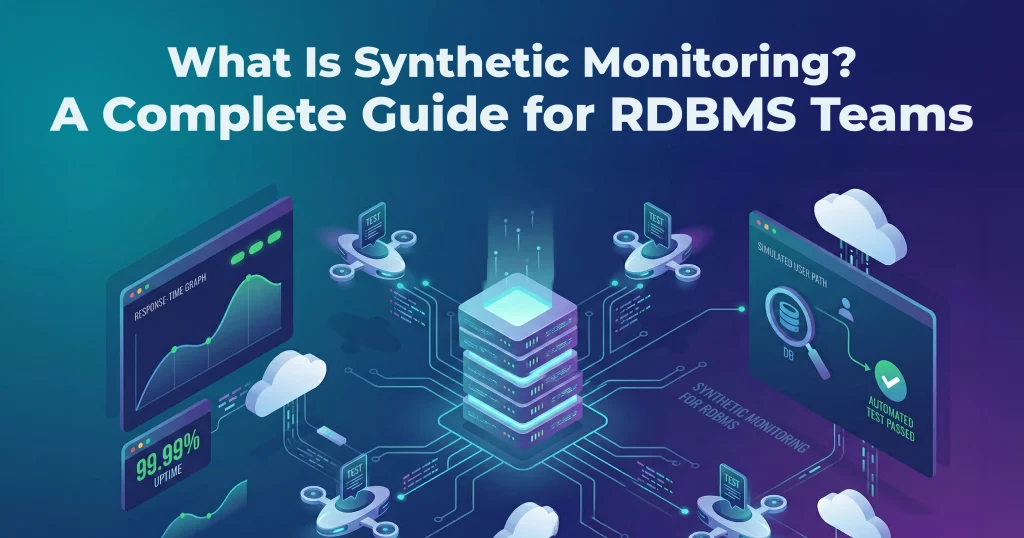
In today’s digital ecosystem, system failures, slow responses, and downtime can cripple business operations, erode user trust, and violate SLAs. Traditional monitoring often tells you something is broken—after it’s already impacted users. This is where synthetic monitoring comes in—a proactive approach to monitoring that simulates user interactions to detect issues before real users do. In this guide, we’ll explore synthetic monitoring in depth, focusing on how it can benefit database teams, and introduce Clonetab CT-MON as an enterprise-grade solution designed for modern, complex environments. What Is Synthetic Monitoring? Synthetic monitoring, sometimes called proactive or simulated monitoring, empowers you to monitor the health and performance of critical endpoints such as databases and application URLs. With continuous monitoring and intuitive dashboards featuring both visual and audio warnings, you can proactively identify and resolve issues before they disrupt your users. Key Components: Why Synthetic Monitoring Is Essential for Web Applications APIs are the connective tissue of modern applications. When an API fails or slows down, the ripple effect can disrupt entire workflows. Benefits: Example Use Case: For example, in an Oracle E-Business Suite (EBS) environment, after completing a clone or refresh, the application services may be up, but the login page (OACORE) might still be unavailable due to hostname changes, listener issues, or invalid configurations. By monitoring this URL and validating login automatically, teams can immediately know whether the application is ready for use, without waiting for manual checks or user complaints. Why Monitoring Database Accessibility is Essential Relational databases are at the core of most enterprise applications, and even small connection issues can interrupt testing, integrations, or scheduled jobs. In non-production environments, databases are frequently restarted, refreshed, or reconfigured—and connectivity problems often go unnoticed until an application fails or a developer reports an error. Automated database connection monitoring ensures that any connectivity, authentication, or listener-related issues are detected immediately. For example, after refreshing a test or development database, the service may appear “running,” but applications might still fail to connect due to incorrect connection strings, missing network routes, outdated listener settings, or firewall rules. Automated checks that periodically attempt a database login help teams quickly verify that the environment is actually usable and responsive, without relying on manual testing. How Synthetic Monitoring Helps: Clonetab CT-MON supports Oracle, PostgreSQL, MySQL, and other relational databases, offering a unified view of database health across on-prem and cloud environments. Key Features of an Enterprise Synthetic Monitoring Solution When evaluating synthetic monitoring tools, look for capabilities that align with operational and compliance needs: Use Cases for Synthetic Monitoring Why Clonetab CT-MON Stands Out Clonetab CT-MON gives teams more than basic uptime checks. It combines automated URL availability monitoring, login validation, and relational database availability checks into a unified view—fully deployable within your own environment to ensure complete data privacy and control. Ideal For: Application Administrators who need to confirm URL and login page readiness after refreshes, deployments, or maintenance. Database Teams requiring continuous visibility into database accessibility and connection responsiveness. DevOps & SRE Teams focused on maintaining environmental reliability, early issue detection, and meeting internal uptime expectations. Conclusion: Synthetic monitoring brings a strong “shift-left” mindset to reliability—helping teams catch availability issues early in development, testing, and staging environments, while maintaining continuous assurance in production. For application and database teams, using a tool like Clonetab CT-MON means moving from reactive problem-solving to proactive stability management. By continuously checking URL availability, validating login readiness, monitoring database accessibility, and tracking performance trends, teams can ensure smooth access to their applications, maintain internal reliability targets, and spend more time on improvement and innovation rather than downtime.
Why RTO/RPO Is Failing Most Companies — And How Automation Fixes It
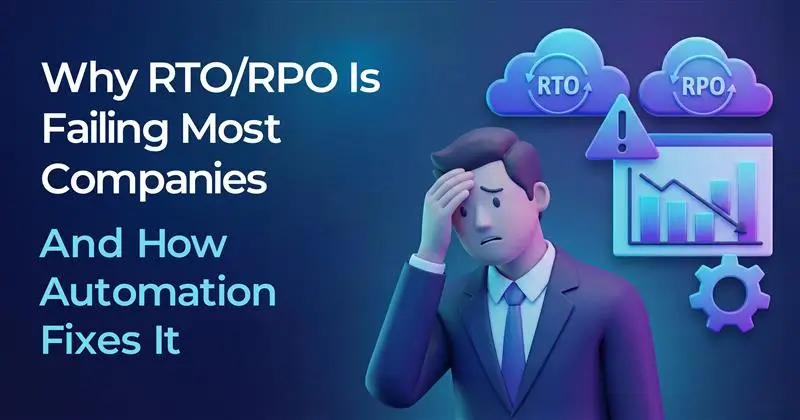
RTO (Recovery Time Objective) and RPO (Recovery Point Objective) are crucial metrics that define how quickly an organization can restore operations and how much data it can afford to lose. Yet, despite their importance, most companies consistently fail to meet these targets. In this blog, we’ll explore why RTO and RPO are failing most companies and how automation in disaster recovery can bridge the gap, ensuring robust business continuity. The Reality of RTO and RPO Failures RTO defines the maximum acceptable downtime after a disaster, while RPO indicates the maximum tolerable data loss measured in time. Ideally, businesses aim to resume operations within the RTO and limit data loss to the RPO. However, surveys show that over 70% of companies fail to meet these objectives during real-world disasters. Common Causes of Failure The Business Impact of Failing RTO and RPO When an organization fails to meet its RTO or RPO, the consequences are severe: How Automation Solves RTO and RPO Failures The most effective way to meet RTO and RPO consistently is through automation. By leveraging intelligent automation in your business continuity and disaster recovery (BC/DR) strategy, organizations can reduce downtime, limit data loss, and achieve predictable recovery outcomes. Key Advantages of Automated DR Solutions Case Study: Automation in Action Consider a mid-sized financial services firm that struggled with manual recovery. During a ransomware attack, it faced an estimated downtime of 12 hours and potential data loss of 8 hours. After implementing an automated disaster recovery solution: This is the transformative power of automation: predictable, repeatable RTO and RPO fulfillment that protects both revenue and reputation. Choosing the Right Automation-Driven DR Solution When selecting an automated disaster recovery solution (CT-DR), organizations should look for: One leading solution that addresses these needs effectively is CT-DR. It leverages automation to simplify DR processes, reduce human intervention, and ensure business continuity—even in the face of complex disasters. Conclusion Failing to meet RTO and RPO is a widespread issue that jeopardizes operations, revenue, and customer trust. Traditional, manual DR processes are no longer sufficient for modern, hybrid IT environments. By adopting automation in disaster recovery, organizations can reduce downtime, limit data loss, and ensure regulatory compliance with confidence. For companies ready to elevate their disaster recovery strategy, CT-DR provides an automated, reliable solution that turns RTO and RPO from aspirational targets into guaranteed outcomes. Ensure your business continuity and disaster recovery are future-ready. Explore CT-DR’s automation-driven solutions and protect your operations today.
Database Protection for 50TB–200TB Databases: Challenges and Enterprise-Grade Solutions
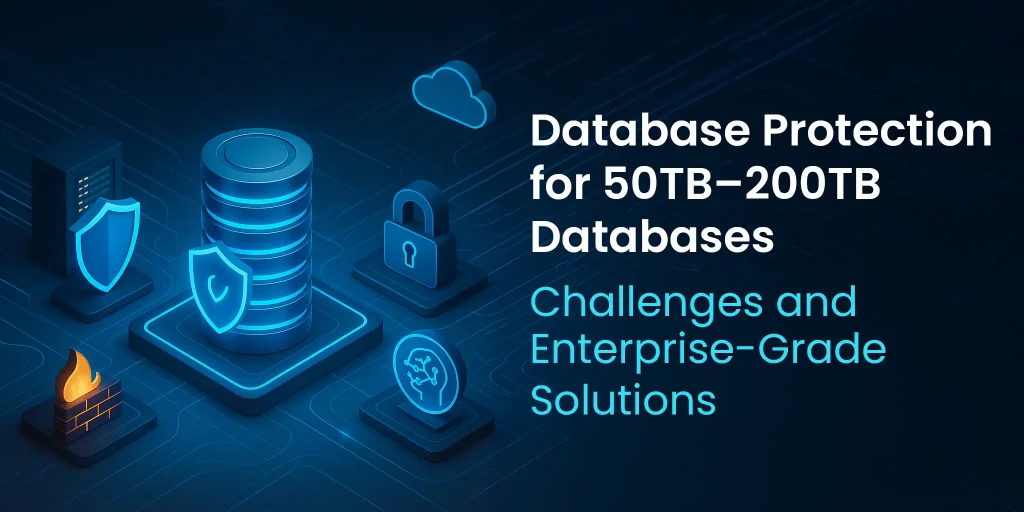
Managing database protection for large 50TB–200TB databases is one of the toughest challenges for modern enterprises. As organizations scale their Oracle EBS, ERP, PeopleSoft, and Exadata systems, the attack surface widens, compliance requirements intensify, and performance pressure skyrockets. Strong data protection frameworks have become critical for CIOs, CTOs, IT Directors, and DBA Managers who must ensure uptime, security, and zero data leakage. Why Database Protection Becomes Harder for 50TB–200TB Databases (Database Protection Challenges) As database sizes grow beyond 50TB, the complexity of database protection multiplies. Traditional security, backup, and cloning processes no longer meet enterprise scalability, performance, or compliance needs. Massive Volume Slows Down Data Protection Processes For large-scale Oracle and ERP systems, maintaining reliable database protection is difficult because multi-terabyte volumes slow down backups, refreshes, and validation steps. Enterprises must rely on automated workflows, intelligent storage systems, and virtualization to enforce consistent data protection across production, development, and DR environments. 1. Backups and Restores Become Unreliable Large databases often experience: Weak backup integrity directly impacts enterprise-wide database security 2. Rising Risk of Data Breaches Large systems have more: Without strong database protection, attackers exploit vulnerabilities through test databases, shadow environments, or unsecured cloud buckets. 3. Dev/Test Environments Are the #1 Source of Leakage Cloning a 50TB–200TB production database exposes: If unmasked, these environments severely compromise database protection. 4. Disaster Recovery Fails to Meet Enterprise SLAs Legacy DR setups fall apart under: Ultimately, the organization loses resilience and database protection becomes fragile. Enterprise Solutions to Strengthen Database Protection (Advanced Database Protection Techniques) To maintain true database protection, enterprises need modern, automated, and scalable technologies specifically built for large systems. Automated Cloning & Virtualization Improve Database Security Enterprise teams are adopting advanced database virtualization to reinforce database protection across every environment. These solutions make clone refreshes faster, enforce data masking, and eliminate manual errors that weaken database security. 1. High-Speed Incremental Database Copying Instead of copying 200TB every time, modern systems use: This reduces downtime and strengthens database protection by ensuring consistent, validated copies. 2. Enterprise Data Scrambling & Masking The biggest threat to database security is exposed non-production data. Automated scrambling protects: While maintaining referential integrity. 3. Automated Disaster Recovery With Ultra-Low RTO/RPO Modern DR platforms enhance database protection using: Why Clonetab Is the #1 Platform for Enterprise-Grade Database Protection (CTA) Clonetab solves every major challenge related to database protection for 50TB–200TB Oracle and ERP databases. Clonetab Offers: Conclusion: The Future of Database Protection Requires Automation, Virtualization & AI As enterprise databases grow from 50TB to 200TB and beyond, the complexity of database protection increases exponentially. Traditional backup and DR methods simply cannot deliver the performance, speed, or reliability global organizations need today. The future belongs to platforms that combine automation, virtualization, AI-driven intelligence, and cloud-ready architecture. Clonetab empowers enterprises across the USA, Europe, Middle East, and APAC to modernize their entire data protection stack—ensuring high availability, security, compliance, and efficiency at unprecedented scale. If your organization is looking to protect mission-critical databases with faster cloning, instant snapshots, automated DR, and secure data masking, Clonetab is the most powerful solution designed for modern global workloads. Explore Clonetab’s Database Protection Solutions →
Top DBA Automation Solutions in 2025: Why Clonetab Is for Modern Enterprises
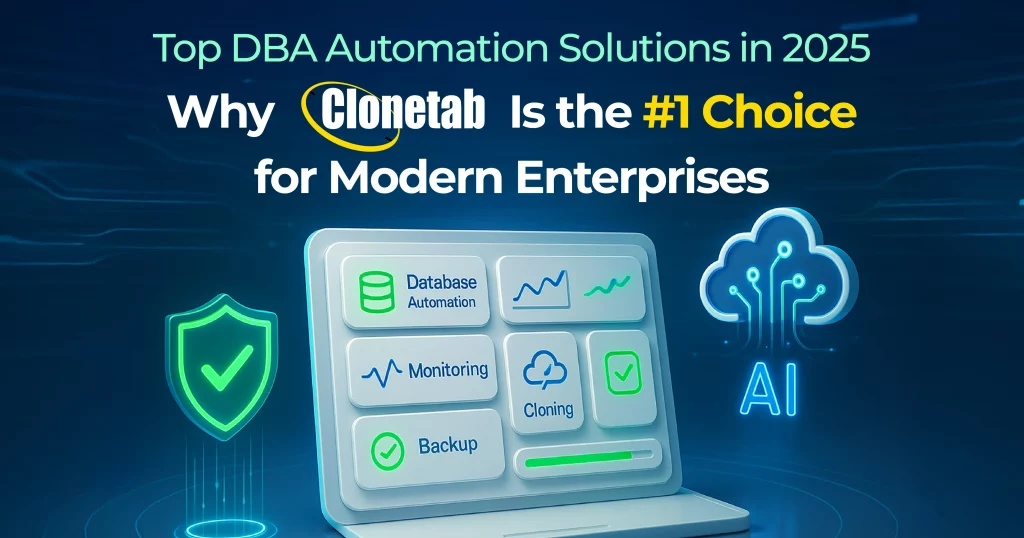
Modern enterprises demand agility, security, and reliability from their database operations. With the rapid growth of cloud adoption, DevOps, and data-driven applications, DBAs are expected to deliver environments faster, ensure compliance, reduce downtime, and maintain operational continuity — all with fewer resources. This shift has made DBA automation one of the most critical priorities in IT organizations today. In this blog, we’ll explore the top DBA automation solutions in the market and explain why Clonetab leads the pack as the most comprehensive, application-aware, and enterprise-ready platform. The Rising Need for DBA Automation As environments grow more complex, the challenges for DBAs multiply: 1. Speed & Agility Manual cloning, refreshes, and environment provisioning can take days or weeks. Automation compresses these timelines to hours or minutes — empowering DevOps and reducing dependency on manual intervention. 2. Cost Optimization Full database copies consume huge storage volumes. Virtualized or thin clones dramatically cut costs and reduce infrastructure overhead. 3. Security & Compliance Regulated industries require tight controls, data masking, audits, and governance. Automated workflows ensure consistency and eliminate human error. 4. Disaster Recovery Readiness DBAs must maintain low RTO/RPO and perform regular DR tests. Automated DR workflows increase resilience and reliability. 5. Developer Productivity Developers and QA teams work best with fresh, production-like data. Automated on-demand cloning fits directly into modern CI/CD workflows. Leading DBA Automation Platforms Today Many tools exist in the market, each solving parts of the automation puzzle: However — these platforms often lack end-to-end automation, are not application-aware, or do not offer DR, backups, ERP-level automation, or integrated data masking in a single suite. This is where Clonetab shines. Why Clonetab Is the Best Choice for DBA Automation Solutions Clonetab is built from the ground up to solve the real challenges of enterprise DBAs — not just database versioning or migrations, but full cloning, Disaster Recovery (DR), snapshots, data scrambling, ERP automation, and secure self-service. Here’s how Clonetab compares to other solutions: Comparison: Clonetab vs Other Top DBA Automation Solutions (2025) Feature / Capability Clonetab Delphix Redgate SQL Toolbelt DBmaestro Liquibase / Flyway Full-Stack Cloning (App + DB) Yes — ERP-aware (Oracle EBS, PeopleSoft, etc.) with automated post-clone steps Partial (DB-focused, limited app context) No No No Database Virtualization / Thin Clones Yes (80%+ storage savings) Yes Limited No No Integrated Data Masking / Scrambling Yes (built-in masking during clone or standalone) Yes No (add-ons required) No No Disaster Recovery Automation Yes — DR orchestration, snapshot-based time travel, automated rebuilds Limited No No No Backup Automation & Validation Yes — CT-Backup module Limited Partial No No ERP Awareness (Oracle EBS, PSFT) Yes (AD/TXK validations, custom scripts, full-stack automation) No No No No Self-Service SQL Execution (Secure) Yes — CT-S3, role-based, audited, no password exposure No No No No Schema Migration / DevOps CI-CD Partial (integration possible via scripts/API) No Yes Yes — main focus Yes — main focus Audit Trail & Compliance (SOX, PCI) Yes — Role-based access, logs, secure credential wallet Partial Limited Yes Partial Cloud & On-Prem Support Yes — AWS, Azure, OCI, On-Prem, Hybrid Yes Yes Yes Yes Exadata Support Yes — via CT-TransDB / CloneHub Partial No No No Custom Pre/Post Automation Hooks Yes — Highly flexible Limited Limited Limited Limited Time to Clone Full Environments (ERP + DB) Minutes to ~1 hour (even for >10 TB) Hours Not supported Not supported Not supported Cost Efficiency Very High (storage savings + automation savings) Medium (high license cost) Medium Medium High (open source, limited scope) Best Suited For Enterprises needing full DBA automation, ERP-aware cloning, DR, and compliance Data virtualization & masking SQL Server-only teams DB DevOps teams Schema-only versioning Why Enterprises Choose Clonetab Over Other Tools 1. End-to-End DBA Automation Unlike tools that automate only part of the workflow, Clonetab manages the full lifecycle — from cloning to masking, DR, backups, validation, and self-service. 2. Deep ERP Awareness Clonetab understands Oracle EBS, PeopleSoft, and large Oracle workloads — including AD/TXK patch levels and app-specific post-clone steps. 3. Storage and Cost Efficiency Thin clones + compression = up to 80% storage savings, significantly reducing infrastructure costs. 4. Proven at Enterprise Scale Clonetab consistently delivers full ERP & DB clones — even 10TB+ — within under one hour. 5. Secure and Compliance-Ready Built-in masking, role-based access, auditing, and credential management ensure SOX, PCI-DSS, and HIPAA readiness. 6. Developer & QA Empowerment With secure self-service SQL and on-demand cloning, dev/test teams get what they need without overloading DBAs. 7. Flexible, Modular, Cloud-Ready Pick only the modules you need — and deploy on-prem, hybrid, or in any major cloud. Final Verdict: Clonetab Is the Leader in DBA Automation While tools like Delphix, Redgate, DBmaestro, Liquibase, and Flyway each excel in their own niche, Clonetab is the only platform that provides true end-to-end DBA automation: If your organization needs real, enterprise-grade DBA automation — not just schema changes or partial workflows — Clonetab is the clear best choice.
The Future of Data Retrieval: AI-Powered NL2SQL Assistant for Oracle Financials, Supply Chain, and Manufacturing
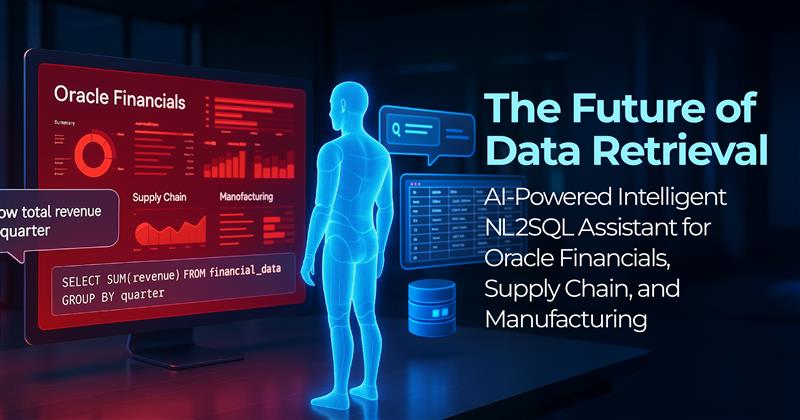
Businesses are increasingly turning to AI-powered solutions to streamline operations and improve decision-making. One of the most exciting innovations in this field is the development of Intelligent AI Powered NL2SQL Assistant for Oracle, which leverage Natural Language Processing (NLP) to transform business queries into SQL commands—without requiring users to have any prior SQL knowledge. This blog explores how AI-driven NL2SQL assistants, specifically trained on Oracle Financials, Supply Chain, and Manufacturing data models, are revolutionizing the way businesses retrieve and interact with data. What is an NL2SQL Assistant? An NL2SQL Assistant is an AI tool that converts questions written in natural language into structured SQL queries. Using advanced natural language understanding (NLU) techniques, the tool interprets user queries in plain English and translates them into SQL syntax. This allows non-technical users to access complex databases with ease—without needing to learn SQL or rely on developers for every data retrieval request. The Power of AI in Data Retrieval AI’s role in modern data retrieval is pivotal. Traditionally, retrieving specific data from large, complex databases like Oracle Financials or Supply Chain models required deep technical expertise in SQL. However, as businesses continue to accumulate vast amounts of data, the need for efficient, intuitive access to this information has grown exponentially. The AI-powered NL2SQL assistant steps in here, simplifying the process. With the ability to understand natural language queries, such as: The assistant generates the corresponding SQL query in the background and retrieves the data instantly. No more waiting for data specialists to write and test complex queries! Oracle Financials, Supply Chain, and Manufacturing Data Models: The Specialized Training What sets this AI-powered assistant apart from general-purpose tools is its training on specific Oracle data models, such as: By being trained on these specialized datasets, the assistant can understand the specific business logic and structure within each model. This means more accurate query interpretation, fewer errors, and faster insights. Key Features of the Intelligent NL2SQL Assistant Use Cases in Different Industries Benefits of Using an Intelligent AI Powered NL2SQL Assistant Challenges and Considerations While AI-powered NL2SQL assistants provide significant benefits, there are a few considerations to keep in mind: As AI and NLP technology continue to evolve, we can expect NL2SQL assistants to become even more powerful and precise. For organizations using Oracle Financials, Supply Chain, and Manufacturing data models, these assistants provide a significant leap forward in simplifying data retrieval and enabling faster, more informed decision-making. With secure, efficient, and intuitive access to critical data, businesses can unlock the full potential of their data and transform their operations for the future. If you’re looking to streamline your data retrieval processes, an intelligent NL2SQL assistant is the perfect solution to help you work smarter, not harder.
The Future of Oracle Database Administrator Jobs: Adapting to Cloud, AI, and Automation
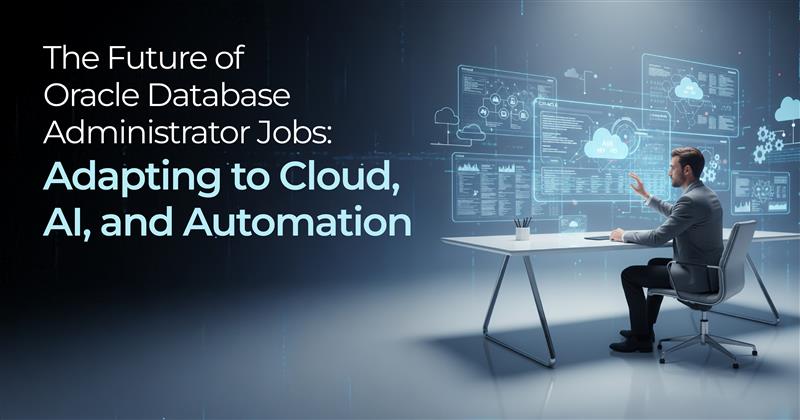
Oracle Database Administrators (DBAs) have long been the backbone of an organization’s database management system, ensuring data availability, integrity, and performance. Traditionally, the role has focused on tasks such as database installation, backups, patch management, and performance tuning. However, as technology evolves, so too does the role of the Oracle Database Administrator Jobs. The future of Oracle Database Administrator jobs is heavily influenced by the rise of cloud computing, automation, and artificial intelligence (AI). As businesses increasingly migrate to cloud platforms like Oracle Cloud Infrastructure (OCI), automate routine database tasks, and leverage AI for performance optimization, the job landscape for DBAs is changing rapidly. In this article, we will explore how Oracle DBAs must adapt to these trends, the skills required to stay competitive, and the future scope of the profession. 1. Cloud Adoption: The Shift to Oracle Cloud Infrastructure (OCI) and Hybrid Environments Cloud Computing: A Game Changer for DBAs Cloud computing has transformed the way businesses manage their IT infrastructure. With cloud services, companies can scale resources quickly, reduce capital expenditures, and ensure high availability without the need for significant on-premise hardware investments. Oracle DBAs are no exception to this shift, as more companies are migrating their Oracle databases to cloud platforms, especially Oracle Cloud Infrastructure (OCI). OCI provides organizations with an integrated suite of cloud applications, platform services, and enterprise-grade database management tools. For Oracle DBAs, this move to the cloud signifies a change in how they perform many of their core responsibilities. Instead of managing physical database servers, Oracle DBAs must now focus on managing databases in a cloud environment, leveraging the flexibility and scalability of OCI to optimize database performance. The Hybrid Cloud Trend While cloud adoption is rising, many organizations still rely on on-premise infrastructure for certain workloads, leading to the widespread use of hybrid cloud environments. Hybrid cloud models combine the best of both worlds—on-premise systems for legacy applications and cloud services for more scalable, flexible database management. For Oracle DBAs, this hybrid model introduces new challenges and responsibilities. They must integrate cloud and on-premise systems, ensure consistent data management, handle migrations, and address issues related to security and compliance. As the demand for hybrid cloud environments grows, Oracle DBAs will increasingly be called upon to bridge the gap between traditional databases and cloud-based solutions. Skills for Cloud-Based Oracle DBAs As the cloud continues to shape the DBA role, Oracle DBAs must expand their skill sets. Familiarity with cloud platforms such as Oracle Cloud, AWS, and Microsoft Azure is crucial. Key skills include: Oracle DBAs with expertise in cloud computing will be in high demand, as businesses continue to embrace cloud-first strategies. 2. Automation in Database Management: Reducing Manual Tasks and Enhancing Efficiency The Rise of Automation One of the most significant trends impacting Oracle DBAs is the rise of automation in database management. Automation tools have the potential to streamline repetitive tasks, improve efficiency, and reduce human error. Tasks such as database provisioning, backup management, patching, performance tuning, and monitoring can now be automated using advanced software tools. Oracle itself has invested heavily in automation, with tools like Oracle Enterprise Manager (OEM) and Oracle Autonomous Database providing DBAs with the ability to automate routine tasks. These tools enable automated database health monitoring, automated patching, self-repair, and performance optimization. For Oracle DBAs, this means a shift away from manual intervention towards more strategic decision-making roles. Benefits of Automation For Oracle DBAs, automation brings several benefits: Future Role of DBAs in an Automated Environment While automation reduces the need for manual intervention, it does not eliminate the role of the DBA. Instead, Oracle DBAs will take on more strategic responsibilities, such as: In the future, Oracle DBAs will evolve from being technicians to becoming more like data strategists and architects, focusing on designing and optimizing automated workflows. 3. The Role of AI in Database Tuning and Performance Optimization AI and Machine Learning in Oracle Databases Artificial intelligence and machine learning are increasingly being integrated into Oracle databases to help automate database tuning and performance optimization. Oracle’s Autonomous Database is one of the leading examples of how AI can be applied to database management. It uses machine learning algorithms to automate tasks such as performance tuning, self-healing, auto-scaling, and auto-patching. For Oracle DBAs, AI means a significant shift in how database optimization is approached. Traditionally, DBAs had to manually identify and resolve performance bottlenecks. Now, AI-powered systems can monitor databases in real-time, learn from patterns, and automatically adjust configurations to optimize performance without human intervention. How AI Improves Database Management DBA’s Role in an AI-Driven Database World Even with AI handling many of the routine optimization tasks, Oracle DBAs will still be responsible for overseeing the AI tools, interpreting the data, and intervening when necessary. The DBA’s role will shift towards: 4. Future Requirements for Oracle Database Administrator Jobs Evolving Skillset for Oracle DBAs As the DBA role evolves, so too must the skills of Oracle professionals. The key areas for Oracle DBAs to focus on in the coming years are: Certifications and Professional Development Oracle DBAs who want to remain competitive in the future job market should pursue certifications and training in key areas: New Career Paths for Oracle Database Administrator Jobs As Oracle databases continue to evolve, new career paths are emerging: Conclusion The future of Oracle Database Administrator jobs is undoubtedly shaped by cloud computing, automation, and AI. As organizations continue to embrace cloud-first strategies and leverage AI for performance optimization, Oracle DBAs will need to adapt their skill sets, learn new tools, and embrace automation to stay competitive. While these technological advancements may change how Oracle DBAs perform their day-to-day tasks, the need for skilled professionals to manage and optimize databases will remain. The key to thriving in this new environment is continuous learning, embracing new technologies, and developing the skills needed to manage Oracle databases in a cloud and AI-driven world. For Oracle DBAs looking to future-proof their careers, now is the time to invest in cloud and AI
What Are Those Challenges Faced During Oracle to PostgreSQL Migration?
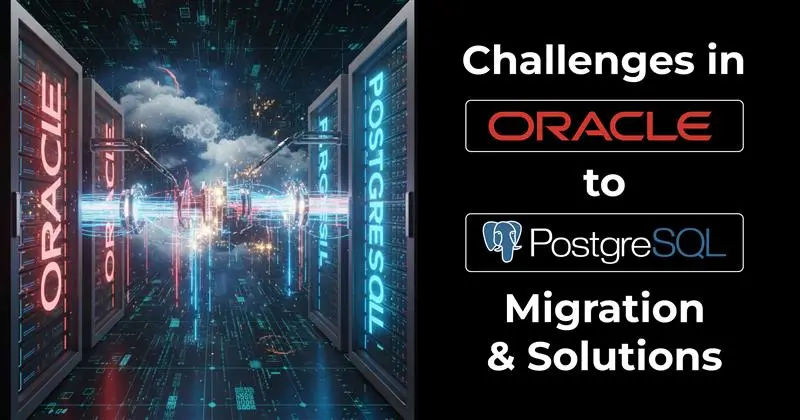
Many organizations are reevaluating their database architectures, and one trend that has been gaining significant momentum is the migration from Oracle to PostgreSQL. As companies seek to reduce costs, avoid vendor lock-in, and embrace open-source alternatives, moving to PostgreSQL has become a popular choice. However, this migration is not without its challenges. Migrating from Oracle to PostgreSQL involves more than just data transfer; it requires a complete overhaul of the database structure, application logic, and business processes that rely on the Oracle ecosystem. In this article, we’ll dive deep into the real-world challenges organizations face during this migration process and how to navigate them. Key Challenges Faced During Oracle to PostgreSQL Migration 1. Data Migration and Compatibility Issues One of the most significant challenges during Oracle to PostgreSQL migration is ensuring that data is properly transferred without corruption or loss. Oracle and PostgreSQL differ in terms of data types, syntax, and storage mechanisms. Real-World Example: A retail company migrating its customer data from Oracle to PostgreSQL encountered issues with large binary objects (BLOBs) that were stored in Oracle. These objects did not transfer seamlessly into PostgreSQL, causing delays in the migration project. 2. Application Code Changes Oracle-based applications often make heavy use of Oracle-specific SQL functions, stored procedures, and triggers, many of which are not directly compatible with PostgreSQL. This means that application code and business logic need to be refactored to work with PostgreSQL’s syntax and capabilities. Real-World Example: An e-commerce platform relying on Oracle’s extensive PL/SQL-based triggers to manage inventory control faced significant delays when migrating to PostgreSQL. They had to rework each trigger and stored procedure to match PostgreSQL’s syntax, leading to unexpected costs and resource allocation. 3. Data Integrity and Consistency During a database migration, ensuring data integrity is crucial. Any migration process carries the risk of inconsistent data if not properly validated. Data integrity issues may arise when: Real-World Example: A financial institution migrating to PostgreSQL from Oracle discovered data integrity issues in their customer account records after the initial migration. The foreign key constraints in Oracle didn’t align correctly with the relational structure in PostgreSQL, leading to data inconsistency. They had to perform an additional round of validation to ensure accuracy. 4. Performance Tuning and Optimization PostgreSQL, while highly capable, requires specific tuning to reach the level of performance that Oracle users are accustomed to. Optimizing query performance in PostgreSQL involves: Real-World Example: A global telecom company migrating from Oracle to PostgreSQL experienced a performance dip in their reporting tools. Complex, resource-heavy queries that ran quickly in Oracle began to perform sluggishly after the migration. It took several months of tuning the PostgreSQL settings and rewriting queries to achieve similar performance levels. 5. Tool and Application Compatibility Many organizations have built sophisticated integrations around Oracle’s ecosystem, such as Oracle BI (Business Intelligence), Oracle RAC (Real Application Clusters), and Oracle Data Guard. Replacing Oracle’s proprietary tools with open-source alternatives that work seamlessly with PostgreSQL can be challenging. Real-World Example: A logistics company that migrated to PostgreSQL from Oracle struggled with integrating their BI reporting tools, which were heavily customized to Oracle’s native SQL. They faced delays in upgrading the reporting system and had to employ a hybrid strategy during the transition. 6. Lack of Skilled Resources Oracle to PostgreSQL migration is a highly specialized task. Many organizations find themselves lacking in-house expertise to handle the intricacies of such a complex migration. Finding skilled professionals who understand both Oracle and PostgreSQL’s architecture, performance tuning, and troubleshooting can be time-consuming and expensive. Real-World Example: A healthcare organization planning to migrate their patient management system from Oracle to PostgreSQL faced difficulties finding experts in PostgreSQL database architecture, resulting in longer project timelines and increased costs. 7. Downtime and Risk Management For mission-critical applications, minimizing downtime during the migration is a top priority. However, the more complex the migration, the harder it becomes to ensure that the transition occurs smoothly without service interruptions. Real-World Example: A manufacturing company migrating its inventory management system to PostgreSQL from Oracle experienced significant downtime during the migration. They faced a huge business risk as the application that manages inventory was down for over 24 hours, impacting their operations. Clonetab: The Solution for Oracle to PostgreSQL Migration Challenges Despite the significant challenges involved, the migration from Oracle to PostgreSQL doesn’t have to be a daunting task. Clonetab, an automated cloning and migration solution, offers a streamlined approach to handle the complexities of this transition. Here’s how Clonetab can help: In conclusion, while migrating from Oracle to PostgreSQL presents several challenges, with the right tools and strategies, it is certainly achievable. Clonetab offers an efficient, automated solution that can simplify and accelerate the migration process, helping businesses reduce risks, optimize performance, and minimize downtime.
From SQL Scripts to Smart Conversations: How AskGuru is Revolutionizing Enterprise Data Intelligence
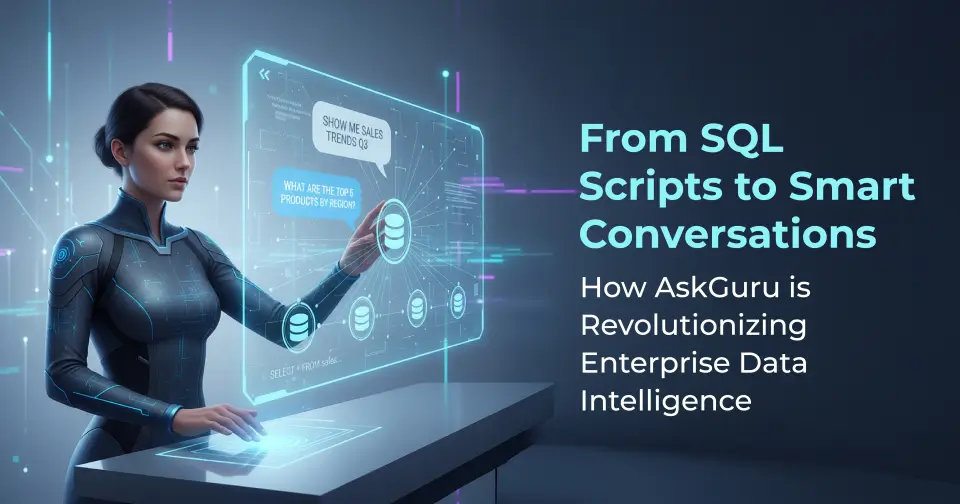
The Legacy Challenge: Data Locked Behind Technical Walls Enterprise systems like Oracle E-Business Suite or SAP hold an organization’s most valuable resource — data. Yet, accessing that data often feels like navigating a labyrinth. A simple business question — “Which suppliers delivered late last quarter?” — can trigger a chain reaction: someone raises a ticket, a report developer writes a SQL query, validation cycles begin, and days later, the answer finally lands in the user’s inbox. This model has persisted for decades. But in today’s world of real-time decision-making, it’s no longer sustainable. The challenges are clear: Enterprises need a way to let data flow as fast as thought — without compromising accuracy or security. The AskGuru Advantage: Turning Questions into Conversations AskGuru, Clonetab’s AI-driven Natural Language Query (NLQ) platform, bridges this gap by letting business users talk to their databases in plain English. It combines Natural Language to SQL (NL2SQL) intelligence with enterprise-specific training to understand and respond to business queries contextually. Instead of writing code, users can simply ask: AskGuru interprets these questions, confirms the user’s intent, generates the corresponding SQL, executes it securely, and delivers the result — instantly. AI That Understands Your Business AskGuru isn’t a generic chatbot. It’s a domain-trained AI system built for enterprise realities. Using Clonetab’s proprietary LLM framework, AskGuru is trained on the data models, relationships, and terminologies of systems like Oracle EBS, SAP, and even custom-built applications. This allows it to: The result? Accurate, business-aware answers, not guesswork. Intelligence with Integrity: How AskGuru Ensures Accuracy Before executing a query, AskGuru performs intent confirmation — a key differentiator in its design. It validates the user’s request by restating what it understood: “Do you want to see vendor ABC Industries Pvt Ltd for the period June 2024?” Only after user confirmation does it run the SQL query. This proactive validation prevents misinterpretation and ensures clean, trusted outputs — a crucial step for data governance and auditability. Flexible Deployment for Every Enterprise AskGuru adapts to your infrastructure and compliance needs: On-Premise Model SaaS Model In both cases, AskGuru ensures secure access, continuous updates, and high availability. Measurable Intelligence: Learning That Evolves AI maturity is a journey. AskGuru’s model continuously refines itself through delta training — a structured process of learning from real user queries over time. This adaptive learning ensures that the more you use AskGuru, the smarter it gets — understanding your organization’s evolving vocabulary and priorities. Transforming Business Roles, Not Replacing Them AskGuru isn’t here to replace analysts or developers. It’s here to empower decision-makers — finance managers, procurement heads, and operations leaders — to ask, explore, and act without delay. By making data conversational, it shifts the enterprise mindset: It’s not just about accessing data faster — it’s about thinking faster as an organization. The Future: Conversational Data Intelligence The next wave of enterprise transformation isn’t about bigger dashboards or more complex analytics tools. It’s about humanizing data interaction. AskGuru represents that future — where anyone in the organization can simply ask a question and get a precise, validated, and contextual answer in seconds. No SQL. No delays. No barriers. Because the future of business intelligence is not about querying data — it’s about conversing with it. Experience the Future of Data Access Empower your teams to make faster, smarter decisions with AskGuru. Discover how conversational AI can turn your ERP data into instant, actionable intelligence.
7 Signs Your Organization Needs an AI-Powered Data Retrieval Tool

Data is one of your organization’s most valuable assets — but only if it’s accessible and usable. Many teams still struggle to extract the right data quickly, facing challenges like slow manual queries, inconsistent reporting, or over-reliance on IT for basic information. If your team spends more time searching for data than using it, you’re likely overdue for a smarter solution. Here are 7 signs your organization needs an AI-powered data retrieval tool — and why acting now could mean the difference between stagnation and scalable success. 1. Data Retrieval Takes Too Long If your employees have to wait hours or even days for a simple report or dataset, you’re losing valuable productivity. Traditional database query methods are often slow and manual, especially for non-technical users who rely on IT or data teams to pull information. An AI retrieval tool can drastically cut down query time by allowing users to ask natural language questions and get real-time, relevant answers — no SQL knowledge needed. 2. IT & Data Teams Are Overwhelmed with Requests When your IT team becomes the go-to source for even the most basic data requests, it’s a sign of inefficiency. This bottleneck delays decision-making and burns out your technical staff. Automated, AI-driven retrieval tools empower business users to self-serve data, freeing your IT team to focus on higher-impact tasks. 3. Inconsistent or Inaccurate Reporting Manual data pulls often lead to discrepancies and errors in reporting. Different teams might use different parameters or outdated datasets, leading to decisions based on conflicting information. AI retrieval tools ensure consistency by accessing centralized sources and using standardized logic across all queries, improving data trust and accuracy. 4. Lack of Data Accessibility for Non-Technical Teams If your marketing, sales, or operations teams can’t independently access the data they need, innovation stalls. These teams are closest to your customers and operations — they need quick insights to make informed decisions. AI-powered tools make data universally accessible through intuitive interfaces that don’t require technical skills, promoting a data-driven culture across your organization. 5. You’re Spending Too Much on BI Tools but Seeing Little ROI Despite investing in expensive BI platforms, you might still find your team underutilizing them due to complexity or training requirements. If dashboards sit unused or require constant maintenance, your return on investment suffers. AI retrieval tools complement your BI stack by simplifying query interactions and helping teams get instant answers without dashboard deep-dives. 6. Your Business Runs on Multiple Data Sources As companies grow, data gets fragmented across CRMs, ERPs, cloud platforms, and legacy systems. Retrieving actionable insights from multiple sources becomes a daunting task. AI retrieval tools are designed to connect with various databases and unify your data search experience, saving hours of effort and reducing data silos. 7. Decisions Are Delayed Due to Lack of Real-Time Data When your organization relies on scheduled reports or periodic updates, you’re always looking at a snapshot of the past. In today’s competitive environment, delayed decisions can cost you opportunities. AI tools allow real-time querying of live databases, empowering teams to act quickly and with confidence. How Clonetab askGuru Solves Your Data Search Challenges If you see your organization in any of the above signs, it’s time to explore how AI can streamline your operations. Clonetab Ask Guru is a cutting-edge AI-powered data retrieval tool designed to eliminate the friction in accessing enterprise data. Whether you’re facing database query automation issues, data search challenges, or need to reduce IT dependency, Ask Guru makes it easy for anyone in your organization to ask questions in plain English and receive accurate, real-time data from across systems. No more bottlenecks, inconsistent reports, or slow insights — just fast, intuitive, and reliable data at your fingertips. Discover if your team is ready for AI-driven retrieval — request a personalized walkthrough.
